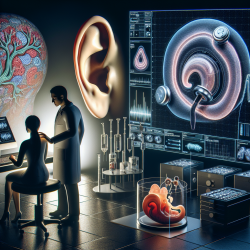Introduction
As a Special Education Director, it is imperative to stay informed about the latest advancements in technologies that can significantly impact the lives of students with special needs. Cochlear implants (CIs) are one such technological marvel that has revolutionized the treatment of profound hearing loss. The research article "Cochlear Implant and Its Related Science" provides a comprehensive overview of recent advancements in CI technology and related sciences. This blog aims to help practitioners improve their skills by implementing the outcomes of this research or encouraging further exploration.
Advancements in Cochlear Implant Technology
The research highlights several advancements in CI technology, including improvements in hardware, expansion of candidacy, and clinical outcomes. These advancements have made CIs more accessible and effective for a broader range of patients, including those with complex medical conditions.
Stem Cell Therapy: A Promising Avenue
One of the most exciting developments in CI-related science is the exploration of stem cell therapy as a new therapeutic strategy. The transplantation of stem cells into the inner ear for hearing restoration is being intensely investigated. Practitioners should consider staying updated on this emerging field as it holds potential for groundbreaking treatments in the future.
Hearing Preservation in CI Surgery
Recent studies have introduced new concepts and technologies for hearing preservation during CI surgery. Surgeons are encouraged to perform electrode insertion trials in ex vivo temporal bones to develop skills for atraumatic surgeries. The use of low-cost dummy electrodes for surgical training is a practical approach to enhance surgical proficiency without incurring high costs.
Bone-Anchored Hearing Aids
Bone-anchored hearing aids (BAHAs) are another option for patients with conductive hearing loss. Although more expensive and invasive than conventional hearing aids, they offer stability and effectiveness. Practitioners should weigh the benefits and risks of BAHAs and consider them as a viable option for certain patients.
Diagnostic Imaging Before CI
The diagnostic value of high-resolution computed tomography (HRCT) and magnetic resonance imaging (MRI) before CI is emphasized in the research. These imaging techniques are crucial for assessing the safety and effectiveness of CI in patients with brain and inner ear abnormalities. Practitioners should ensure thorough preoperative evaluations using these advanced imaging modalities.
Auditory Rehabilitation and Social Cognition
The research underscores the importance of auditory rehabilitation, including social rehabilitation, to maximize postoperative CI outcomes. Performance intelligence, particularly social cognition, is strongly related to CI outcomes. Practitioners should incorporate social skills training into rehabilitation programs to enhance overall success.
Conclusion
The research article "Cochlear Implant and Its Related Science" offers valuable insights into the advancements and challenges in CI technology. Practitioners are encouraged to implement these findings in their practice and pursue further research to continue improving outcomes for individuals with hearing impairments.
To read the original research paper, please follow this link: Cochlear Implant and Its Related Science.










